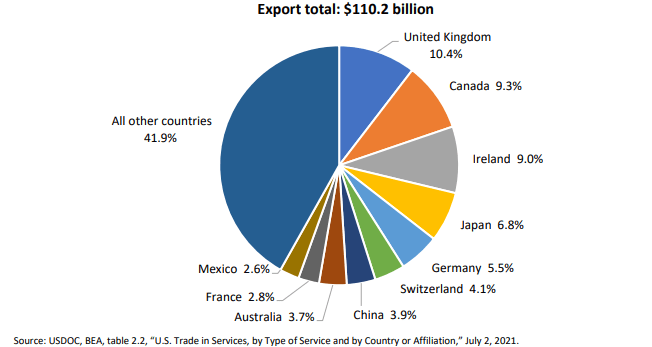US exports of digital and electronic services totaled $110.2 billion in 2020, according to a report by the International Trade Commission (USITC).
The amount represents 16.1% of total US cross-border exports and a 3% decrease in such exports compared to 2019.
The main export destinations included the United Kingdom (10.4%), Canada (9.3%) and Ireland (9 percent).
Conversely, US imports of electronic and digital services totaled $71.3 billion in 2020, representing 16.4% of total US cross-border imports and a 3.8% decline in such imports compared to 2019.
Digital and electronic services: US. cross-border exports, by country, 2020 (percent)

The main sources of cross-border imports included India (17.9%), Canada (11.7%) and the United Kingdom (9.5 percent).
For the purposes of this report, the category of digital and electronic services includes audiovisual, computer, information, telecommunications and software services. These service industries are highly interdependent.
For example, computer services are essential for the provision of telecommunications services, while telecommunications networks allow the trade of audiovisual content.
They also increase productivity and enable trade in other industries, such as education, finance, health care, and logistics.
However, these services are traded electronically, for example when a provider in one country offers data processing services to a consumer in another.
Exports
These US industries are highly competitive, and US companies are among the world leaders in technology adoption and research and development.
By facilitating data and information flows, companies in the digital and electronic sector provide critical infrastructure for the US and global economies.
Digital and electronic services, a data category used by the USITC for this report, comprises five categories defined by the Bureau of Economic Analysis (BEA): telecommunications services, information services, audiovisual services, computer services, and computer software.
In turn, the category of telecommunications services includes the broadcast or transmission of sound, images, data or other content by electronic means (but excludes the value of the content itself).
Other categories
Information services include news agency services, database services, and Internet search services.
For its part, audiovisual services include the production of audiovisual content (such as films, television programs and sound recordings), as well as the rights to use, reproduce and distribute said content.
Computer services consist of cloud computing, data storage and processing services, and services related to the installation and maintenance of computers.
Finally, the computer software category includes software sales and licenses to use, reproduce, and distribute computer software (including software downloaded from the Internet or subscriptions for online access), but excludes sales of software on physical media.
![]()

